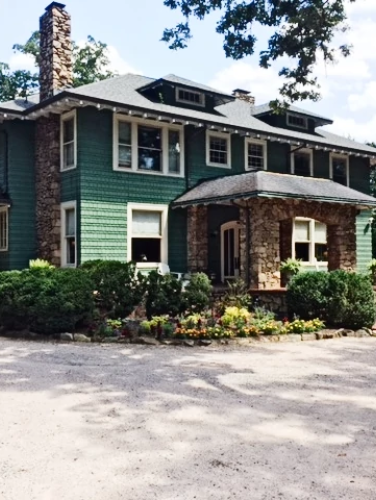
VanLandingham House
(ca. 1914)
Home of affluent cotton broker Ralph VanLandingham designed by Charlotte’s first full-time professional architect Charles Christian Hook.
2010 The Plaza, Charlotte, NC 28205
Built for Ralph and Susie Harwood VanLandingham, the VanLandingham Estate is an early and rare local example of the California bungalow architectural style popular on the West Coast in the early twentieth century. Seeking a new home in the “latest” style, the VanLandinghams commissioned noted Charlotte architect Charles Christian Hook to design the house for construction on four lots purchased by Susie following the couple’s 1907 relocation to Charlotte from Atlanta. Their move was prompted by Ralph’s decision to join the local cotton brokerage firm headed by his father John Henry VanLandingham. It proved to be a shrewd decision, as Ralph quickly became a successful and affluent cotton broker, while both he and Susie became prominent citizens in the community.
Property Quick Links
A Charlotte native, Ralph VanLandingham (1875-1959) served extended tenures as senior warden of St. Peter's Episcopal Church and as treasurer of the Charlotte Country Club. His civic activities extended to Linville, North Carolina, where the family maintained a summer home and where he served as treasurer and senior warden of All Saints Episcopal Church. He lived in the house on The Plaza until his death in 1959. As an Atlanta resident, prior to her 1901 marriage to Ralph, Susie Harwood VanLandingham (late 1860s-1937) served as an officer of the Atlanta Y.M.C.A., helped establish the Atlanta Art Association, and even headed the company that built Georgia’s first fireproof hotel. She continued her active civic engagement following her move to Charlotte, chairing the North Carolina Board of Approved Schools, serving as Board president for St. Peter’s Hospital, and earning a personal presidential commendation from Woodrow Wilson for her supervision of the Red Cross Canteen at Camp Greene during WWI. She also provided generous support for Linville’s Crossnore Industrial School for Mountain Children. The VanLandingham’s twin children retained ownership of the estate until 1970, when the house was transferred to the University of North Carolina at Charlotte according to the terms of Ralph Jr.’s estate. The house has since reverted to private ownership.
Born in Wheeling, West Virginia, Charles Christian Hook (1870-1938) graduated from Washington University in St. Louis, Missouri, before moving to Charlotte in 1890, where he became the city’s first full-time professional architect. Hook is remembered as one of North Carolina’s most prolific architects in the early twentieth century. His design projects span the state, ranging from Romanesque Revival and Colonial Revival styles to Italianate and Beaux-Arts, although he is best known for his Colonial Revival designs. His Charlotte commissions included Charlotte City Hall, the U.S. Post Office and Courthouse, Fire Station No. 6, the Carolina Theater, the Century and Gateway Buildings, the Charlotte Womens’ Club, the Duke Mansion, and several houses in the Dilworth, Hill Crest, Colonial Heights, Wilmore, and Piedmont Park neighborhoods. Other notable works include Statesville’s Billingsley Hospital, Wilmington’s Elks Building, Blowing Rock’s Episcopal Church, and numerous collegiate buildings, including Phillips Hall at UNC-Chapel Hill, Patterson Hall at North Carolina State University, Eliza Pittman Memorial Auditorium at St. Mary’s College, Jarvis Hall at East Carolina University, Hayes Hall and four other campus buildings at Queens College, Spencer Hall at Greensboro’s State Normal and Industrial School now known as University of North Carolina at Greensboro, and Bivens Hall and Alumni Memorial Gymnasium at Duke University.

